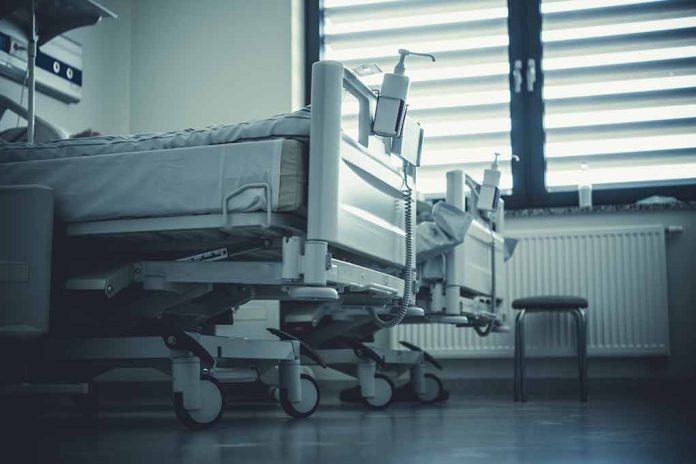
One death and 12 hospitalizations mark Sydney’s alarming Legionnaires’ disease outbreak, as authorities race to decontaminate the CBD cooling tower found harboring the deadly bacteria.
Key Takeaways
- Sydney health officials have reported 12 cases of Legionnaires’ disease and one death among people who visited the CBD between March and April.
- Authorities identified Legionella bacteria in one of 165 tested cooling towers, which is currently undergoing decontamination.
- Symptoms including fever, chills, cough, and breathing difficulties can take up to 10 days to appear after exposure.
- A second outbreak has now occurred in Potts Point, with three more people hospitalized with the severe pneumonia-causing infection.
- The disease is not transmitted person-to-person but spreads through contaminated environmental sources like cooling systems.
Deadly Outbreak in Sydney’s Business District
Sydney’s central business district is facing a serious health crisis as officials confirm one death and multiple hospitalizations from Legionnaires’ disease. New South Wales Health has reported 12 cases of the potentially fatal bacterial infection among individuals who spent time in the city and surrounding suburbs between March and April. Of those infected, 11 required hospitalization while one was treated as an outpatient. The outbreak represents a significant public health concern, highlighting the ongoing vulnerability of urban infrastructure to bacterial contamination.
In response to the outbreak, authorities have undertaken extensive testing of 165 cooling towers throughout the affected area. These towers, common in large buildings for air conditioning systems, are notorious breeding grounds for the Legionella bacteria when improperly maintained. Testing has identified one contaminated cooling tower, which is currently undergoing thorough decontamination procedures to eliminate the dangerous pathogen. Further testing is being conducted to definitively confirm this tower as the source of the deadly outbreak.
Second Outbreak Hits Potts Point
In an alarming development, health officials have now identified a second outbreak in Sydney’s Potts Point area, with three additional people hospitalized. The patients, ranging in age from their 40s to 70s, apparently have no connection to each other but developed the infection around the same time. This pattern suggests a common environmental source in the area, raising concerns about potentially widespread contamination in Sydney’s cooling systems. The proximity of two outbreaks in different parts of the city points to possible systemic maintenance issues.
“People can be exposed to the bacteria if contaminated water particles from a cooling system are emitted into the air and breathed in,” said Dr. Vicky Sheppeard.
The second outbreak has intensified fears among local residents and business owners in Potts Point. Many are taking preemptive measures, including inspecting their ventilation systems and implementing additional cleaning protocols. The proximity of these cases, both geographically and temporally, suggests a potentially serious public health situation developing across Sydney. While authorities emphasize the need for vigilance, they are also working to prevent panic among the population as they continue their investigation.
Symptoms and Public Health Response
Legionnaires’ disease presents as a severe form of pneumonia with symptoms including fever, chills, cough, and significant breathing difficulties. These symptoms typically appear between two and ten days after exposure to the bacteria, making it difficult to immediately identify an outbreak. NSW Health is urging anyone who visited the affected areas during the specified timeframes to monitor for symptoms and seek prompt medical attention if they develop. Early treatment with appropriate antibiotics significantly improves outcomes for those infected.
“I thought it was just the weather turning. But now I’m watching every breath. It’s scary, honestly,” said Jane Harris.
NSW Health is collaborating closely with the City of Sydney to inspect and sample cooling towers potentially linked to both outbreaks. Officials note that most building owners have complied with the NSW Public Health Regulation 2022, which mandates proper operation and maintenance of cooling systems. However, these outbreaks highlight the critical importance of rigorous adherence to maintenance protocols. The disease cannot spread from person to person, so control efforts focus entirely on identifying and eliminating environmental sources of the bacteria.
Business Impact and Community Concern
Local businesses in both affected areas are reporting customer concerns and implementing additional precautionary measures. Restaurant and café owners have been particularly affected as customers question the safety of indoor dining. Some establishments have voluntarily closed temporarily while their buildings’ cooling and ventilation systems undergo inspection and cleaning. These preventive measures represent significant economic impacts beyond the direct health consequences of the outbreak.
“We can’t take chances. Customers ask if it’s safe to sit inside. I can’t blame them,” said Mark Talbot.
As investigations continue, health authorities are reminding building owners throughout Sydney of their legal obligation to maintain cooling towers and prevent bacterial growth. The recent outbreaks serve as a stark reminder of the potentially deadly consequences when infrastructure maintenance falls short. With one death already confirmed and multiple hospitalizations, the situation underscores how seemingly mundane aspects of urban infrastructure management directly impact public health and safety.







